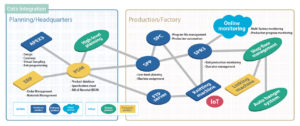 Japanese computerized flat knitting machine manufacturer Shima Seiki has announced the release of its new Shima KnitPLM® software specifically engineered for the flat knitting industry. Today’s apparel industry is evolving at a rapid pace. New forms of retail such as fast fashion and e-commerce require new production infrastructure that support quick response and mass customization, and smart factories utilizing Industry 4.0 and IoT are key to the future of industry success. To that end Shima Seiki has been introducing various products and services to enhance its total fashion system which advocates fully integrated apparel manufacturing from planning and design to production and sales promotion. Initiatives that have already materialized include the new “staf” web-based fashion trend archive that supports fashion planning, the SPS (Shima Private Server) cloud-based point-of-sales tool, and the Virtual Fitting System virtual-reality based fitting room. To further support knit manufacturing in the 21st century, Shima Seiki has developed the world’s first PLM (Product Lifecycle Management) system dedicated to flat knitting as a powerful implementation of IoT for realizing factory automation. With Shima KnitPLM, the entire manufacturing process of knitwear from planning to production can be visualized to support efforts in maximizing production efficiency throughout. To this end, Shima Seiki has released as part of Shima KnitPLM: SPP and SPC. Shima Production Planning (SPP) software manages production scheduling and machine assignment based on manufacturing order (MO) information managed by the user’s existing ERP (Enterprise Resource Planning) system. Even users without ERP can input MO information from a dedicated input menu. Production plans created with SPP can be sent automatically to SPR3, where progress can be managed according to schedule.
Japanese computerized flat knitting machine manufacturer Shima Seiki has announced the release of its new Shima KnitPLM® software specifically engineered for the flat knitting industry. Today’s apparel industry is evolving at a rapid pace. New forms of retail such as fast fashion and e-commerce require new production infrastructure that support quick response and mass customization, and smart factories utilizing Industry 4.0 and IoT are key to the future of industry success. To that end Shima Seiki has been introducing various products and services to enhance its total fashion system which advocates fully integrated apparel manufacturing from planning and design to production and sales promotion. Initiatives that have already materialized include the new “staf” web-based fashion trend archive that supports fashion planning, the SPS (Shima Private Server) cloud-based point-of-sales tool, and the Virtual Fitting System virtual-reality based fitting room. To further support knit manufacturing in the 21st century, Shima Seiki has developed the world’s first PLM (Product Lifecycle Management) system dedicated to flat knitting as a powerful implementation of IoT for realizing factory automation. With Shima KnitPLM, the entire manufacturing process of knitwear from planning to production can be visualized to support efforts in maximizing production efficiency throughout. To this end, Shima Seiki has released as part of Shima KnitPLM: SPP and SPC. Shima Production Planning (SPP) software manages production scheduling and machine assignment based on manufacturing order (MO) information managed by the user’s existing ERP (Enterprise Resource Planning) system. Even users without ERP can input MO information from a dedicated input menu. Production plans created with SPP can be sent automatically to SPR3, where progress can be managed according to schedule.
Shima Production Control (SPC, data distribution system) is still the norm for knitting data at the factory to be prepared and sent manually to each machine via network or USB device. SPC can automatically send the required production data to individual machines based on scheduling data provided by SPP, reducing workload and preventing mistakes.




